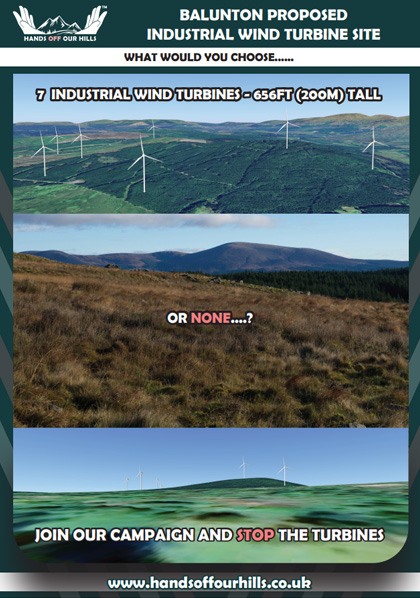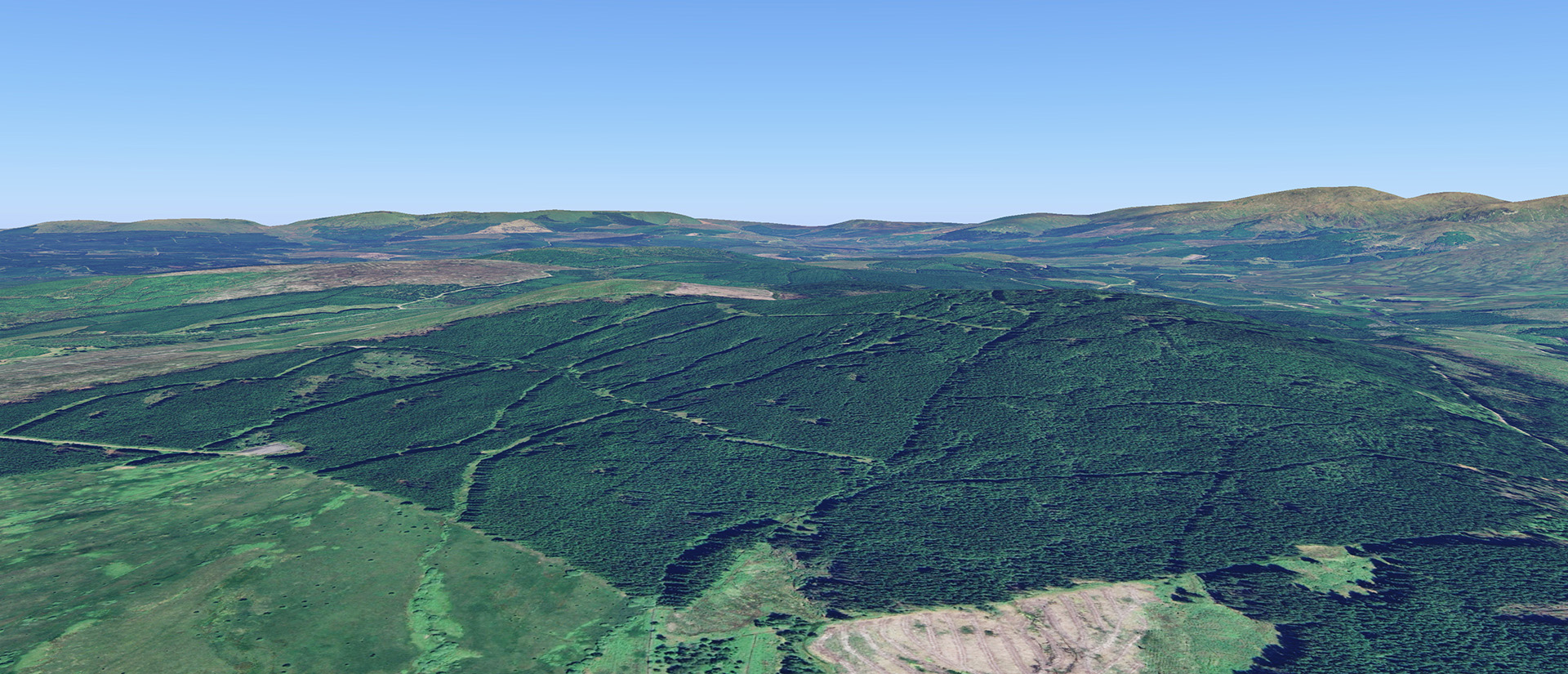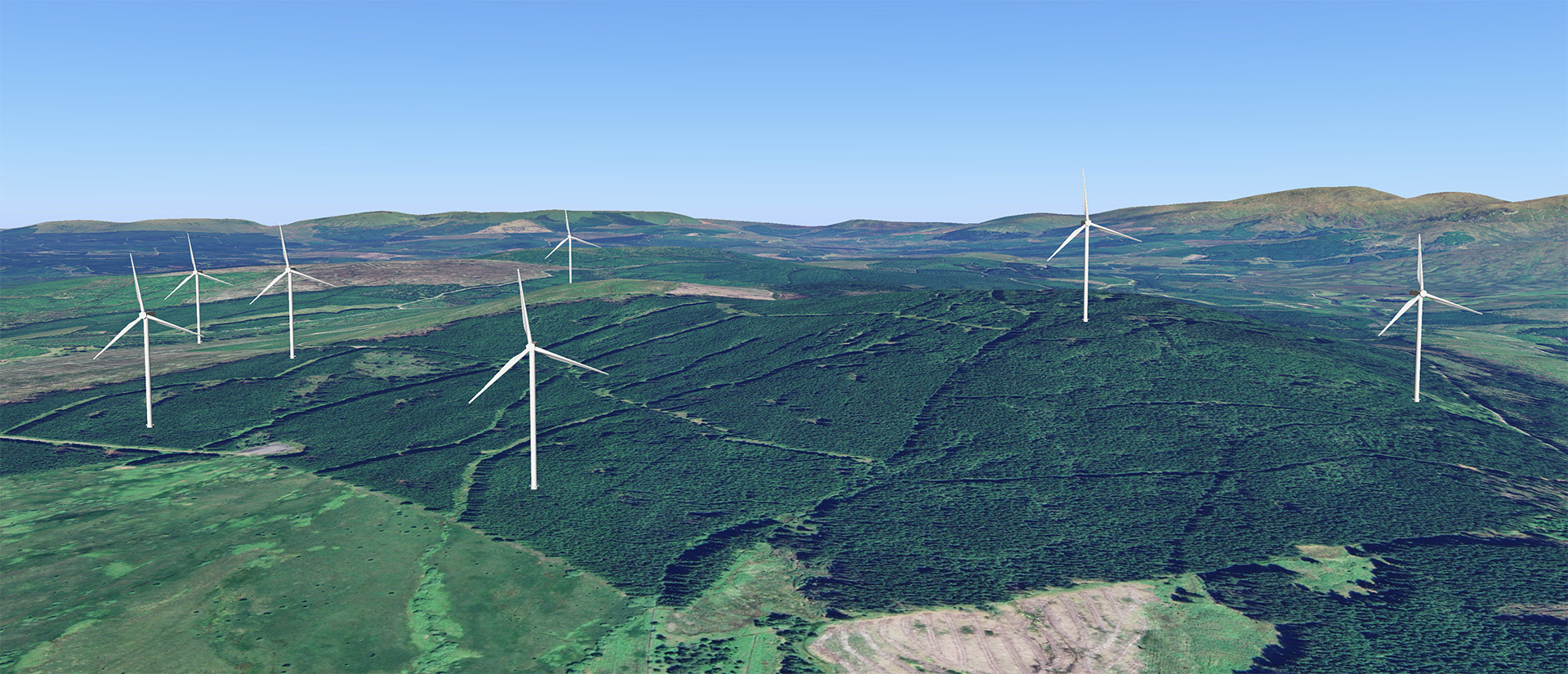Balunton Wind Farm - ECU (Pending)
Balunton Wind Farm proposed by EnergieKontor is an Industrial Wind Turbine Site would be located 2km North-West of Glentrool, with the centre of the site approximately located at: Easting and Northing (E) 234795, (N) 580505.
Each proposed turbine at Balunton Wind Farm would be 656 feet tall or 200 meters tall from base to blade tip. Each turbine would be seen from over 25km away from the site depending on landscape, buildings and trees in the sight of line.
Proposed Development
And Amazing Landmarks Surrounding
White Cairn, chambered cairn 630m W of Glentrool School
The monument comprises a chambered cairn situated within a clearing amidst forestry plantings.
Belonging to the Bargrennan group, the cairn’s dimensions are 17.6m NE-SE by 15.3m, with a height of 1.4m. Subject to excavation in 1949, it features a single chamber accessible from the SSE via a passage of matching width. The surviving roofing stones within the chamber appear to be in their original positions rather than replacements.
The designated scheduling area is circular, measuring 30m in diameter. It encompasses the cairn and its immediate surroundings, ensuring the inclusion of pertinent evidence concerning its construction and historical usage, as delineated in red on the accompanying map.
According to information from Historic Environment Scotland:
This monument holds national significance as a well-preserved tomb representing the Bargrennan group, vividly illustrating the distinctive attributes of its classification. Despite previous excavations, substantial archaeological potential likely remains, exemplified by recent discoveries of Neolithic pottery within a limited, disturbed section of the chamber floor.
Additionally, the cairn’s structure is anticipated to preserve deposits offering insights into past environments and land-use practices.
Bruce’s Stone – Loch Trool
Bruce’s Stone commands a strategic viewpoint, offering panoramic vistas of the glistening waters of the loch and the undulating hills beyond.
This monument commemorates Robert the Bruce, the King of Scotland, and the historic Battle of Trool in 1307.
Despite the serene appearance of the current landscape, it’s noteworthy that a fierce battle unfolded here seven centuries ago. Standing at the stone’s location, observers would have witnessed the dramatic events as English soldiers were ambushed along the far shore of Loch Trool.
A bugle signaled the approach of the troops to the Steps of Trool, where Bruce’s forces unleashed a barrage of stones on the unsuspecting soldiers. Those who attempted to flee encountered heavily armed adversaries behind them, resulting in a swift and bloody victory.
Following this triumph, Robert the Bruce went on to secure Scotland’s independence by winning the Battle of Bannockburn near Stirling in 1314.
Galloway Oakwoods SAC
Designated Special Area of Conservation.
This collection of oakwoods stands as the exclusive site within the SAC series that represents the Atlantic Bryophyte zone in the South-west Lowlands of Scotland.
Despite the small and scattered nature of individual sites, they hold regional significance owing to the highly fragmented state of remaining semi-natural woodlands in south-west Scotland.
The complex showcases well-preserved instances of ancient sessile oak woods, some of which have undergone coppicing in the past. Notably, it houses a distinctive oceanic bryophyte flora, featuring species that are uncommon in this region.
These areas typically boast diverse collections of Atlantic mosses and liverworts, along with flourishing lichen communities and ferns, such as the hard fern Blechnum spicant.
The understorey commonly includes the presence of Holly (Ilex aquifolium).
Glentrool
And Surrounding Towns & Villages
Economy
Newton Stewart and its surrounding region heavily depend on tourism throughout the year to maintain the financial viability of local businesses. Visitors are drawn to the untapped natural beauty of Newton Stewart, Glentrool, and neighbouring villages, engaging in activities such as hillwalking, cycling, and photography amidst the serene Galloway Hills.
The proposed installation of large industrial wind turbines, reaching a height of 200 meters, is expected to directly impact tourism in the area. Studies indicate a correlation between the presence of such turbines and a decline in tourism.
Community benefit funds offered by the EnergieKontor are perceived by some as attempts to offset the impact of the turbines on the landscape and the associated financial repercussions for the community. The question arises as to why cash incentives are deemed necessary if these companies and the Scottish Government are confident in the environmental benefits of such initiatives?
Light Pollution
In adherence to regulations outlined by the UK Civil Aviation Authority, each turbine is obligated to feature a continuously illuminated aviation beacon positioned at its apex. These bright red lights are operational 24/7, ensuring compliance with aviation safety standards.
However, the persistent radiance of these lights presents a challenge to upholding Dark Sky Status in the surrounding area, contributing significantly to light pollution. This light pollution poses an impediment to the visibility of stars and the solar system during nighttime hours, impacting enthusiasts of astronomy in the vicinity.
The Gold Status currently held by Galloway Forest Park is at risk of being compromised due to the intense light emitted by these turbines during the night.
Saturation
Dumfries and Galloway currently accommodates more than 30 Industrial Wind Turbine Sites, featuring a cumulative total of over 590 turbines.
Our research suggests that Dumfries and Galloway has made a substantial contribution to green energy production, albeit acknowledging that the environmental impact of Industrial Wind Turbine Sites may not align seamlessly with their designation as “Green Energy.”
The saturation of such sites prompts a critical examination of the necessity for the inclusion of the Balunton Industrial Wind Turbine Site in the Scottish Government’s objectives for carbon emissions reduction. As of now, empirical evidence supporting the requirement for the Balunton site within the context of these goals remains unsubstantiated.
Futher Information
If you’d like more details about how the Balunton industrial wind turbine site might affect Glentrool or Newton Stewart and the surrounding villages, feel free to reach out to us. We’d be delighted to share a comprehensive list of information with you. Alternatively, you can check out our FAQ section, where you might find the additional information you’re looking for.







